
The cicadas are a superfamily, the Cicadoidea, of insects in the order Hemiptera. They are in the suborder Auchenorrhyncha, along with smaller jumping bugs such as leafhoppers and froghoppers. The superfamily is divided into two families, the Tettigarctidae, with two species in Australia, and the Cicadidae, with more than 3,000 species described from around the world; many species remain undescribed.

Magicicada is the genus of the 13-year and 17-year periodical cicadas of eastern North America, consisting of seven species. Although they are sometimes called "locusts", this is a misnomer, as cicadas belong to the taxonomic order Hemiptera, suborder Auchenorrhyncha, while locusts are grasshoppers belonging to the order Orthoptera. Magicicada belongs to the cicada tribe Lamotialnini, a group of genera with representatives in Australia, Africa, and Asia, as well as the Americas.
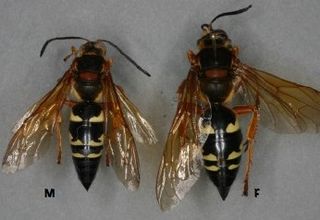
Sphecius speciosus, often simply referred to as the cicada killer or the cicada hawk, is a large digger wasp species. Cicada killers are large, solitary wasps in the family Crabronidae. The name may be applied to any species of crabronid that preys on cicadas, though in North America, it is typically applied to a single species, S. speciosus. However, since multiple species of related wasps occur, calling it the eastern cicada killer is more appropriate. This species occurs in the Eastern and Midwest U.S. and southwards into Mexico and Central America. They are so named because they hunt cicadas and provision their nests with them. In North America, they are sometimes called sand hornets, although they are not hornets, which belong to the family Vespidae. Cicada killers exert a measure of natural control on cicada populations, thus may directly benefit the deciduous trees upon which the cicadas feed.

Cicada killer wasps are large, solitary, ground-dwelling, predatory wasps. They are so named because they hunt cicadas and provision their nests with them, after stinging and paralyzing them. Twenty-one species worldwide are recognized. The highest diversity occurs in the region between North Africa and Central Asia.

The Auchenorrhyncha suborder of the Hemiptera contains most of the familiar members of what was called the "Homoptera" – groups such as cicadas, leafhoppers, treehoppers, planthoppers, and spittlebugs. The aphids and scale insects are the other well-known "Homoptera", and they are in the suborder Sternorrhyncha.
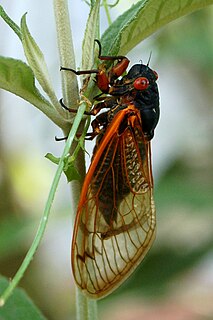
Brood XIX is the largest brood of 13-year periodical cicadas, last seen in 2011 across a wide stretch of the southeastern United States. Periodical cicadas are often referred to as "17-year locusts" because most of the known distinct broods have a 17-year life cycle. Brood XIX is one of only three surviving broods with a 13-year cycle. It is also notable because it includes four different 13-year species, one of which was discovered in Brood XIX in 1998 by scientists listening to cicada songs.

The Cicadinae are a subfamily of cicadas, containing the translucent cicadas. They are robust cicadas and many have gaudy colors, but they generally lack the butterfly-like opaque wing markings found in many species of the related Tibiceninae.

Magicicada cassinii, sometimes called the 17-year cicada, Cassin's periodical cicada or the dwarf periodical cicada, is a species of periodical cicada. It is endemic to North America. It has a 17-year lifecycle but is otherwise indistinguishable from the 13-year periodical cicada Magicicada tredecassini. The two species are usually discussed together as "cassini periodical cicadas" or "cassini-type periodical cicadas." Unlike other periodical cicadas, cassini-type males may synchronize their courting behavior so that tens of thousands of males sing and fly in unison. The species was first described by Margaretta Morris. However, the specific name cassinii was in honour of John Cassin, an American ornithologist.
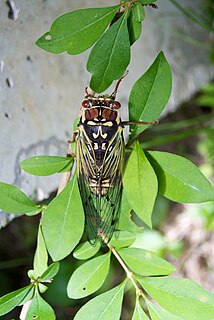
Cryptotympanini is a tribe of cicadas in the family Cicadidae. There are 16 genera and at least 260 described species in Cryptotympanini. They are found in the Nearctic, Palearctic, Indomalaya, Oceania, and tropical Africa.

Neotibicen tibicen, known generally as the swamp cicada or morning cicada, is a species of cicada in the family Cicadidae. It used to be known as Tibicen chloromerus. It is widespread across much of the eastern and central United States and portions of southeastern Canada.
Megatibicen auletes commonly, but informally called the northern dusk-singing cicada, giant oak cicada, or southern oak cicada, is a species of cicada in the family Cicadidae. It is found in the eastern United States and portions of southeastern Canada.
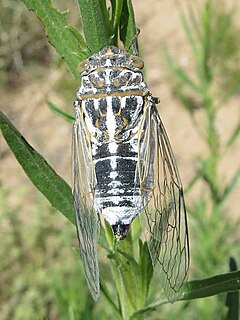
The genus Hadoa comprises large-bodied Cicadidae occurring in Western North America. Until recently, these species were in the genus Tibicen, which has now been redefined so as to include only a few European species, while species from the Eastern US are now placed in Neotibicen and Megatibicen.

The Giant cicada, also known as the chichara grande, coyoyo, or coyuyo, is a species of large cicada native to North, Central, and South America. One of two species in the genus Quesada, it is the widest ranging cicada in the Western Hemisphere.
Hadoa chisosensis is a species of annual cicada in the genus Hadoa. It is native to the U.S. state of Texas.
Hadoa chiricahua is a species of annual cicada in the genus Hadoa. It is endemic to the U.S. states of Arizona and New Mexico.

Megatibicen dorsatus, known generally as the bush cicada or giant grassland cicada, is a species of cicada in the family Cicadidae.

Megatibicen is a genus of cicadas in the family Cicadidae, with about 10 described species. The species formerly of genera Ameritibicen Lee, 2016 and Gigatibicen Lee, 2016 are now considered species of Megatibicen Sanborn & Heath, 2016.
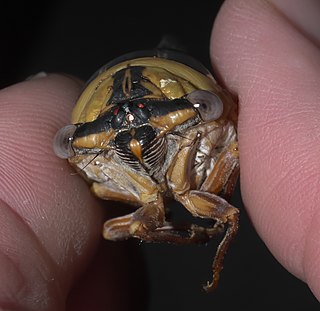
Megatibicen pronotalis, or Walker's cicada, is a species of cicada in the family Cicadidae. It is found in the northern Great Plains of the United States.

Cicadettinae is a subfamily of cicadas in the family Cicadidae. About 230 genera and 1,200 described species are placed in the Cicadettinae.

Neocicada is a genus of cicadas in the family Cicadidae, with about five described species.















